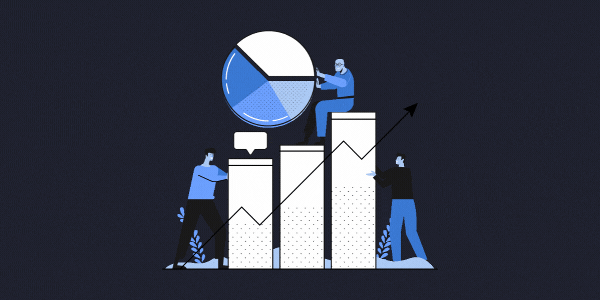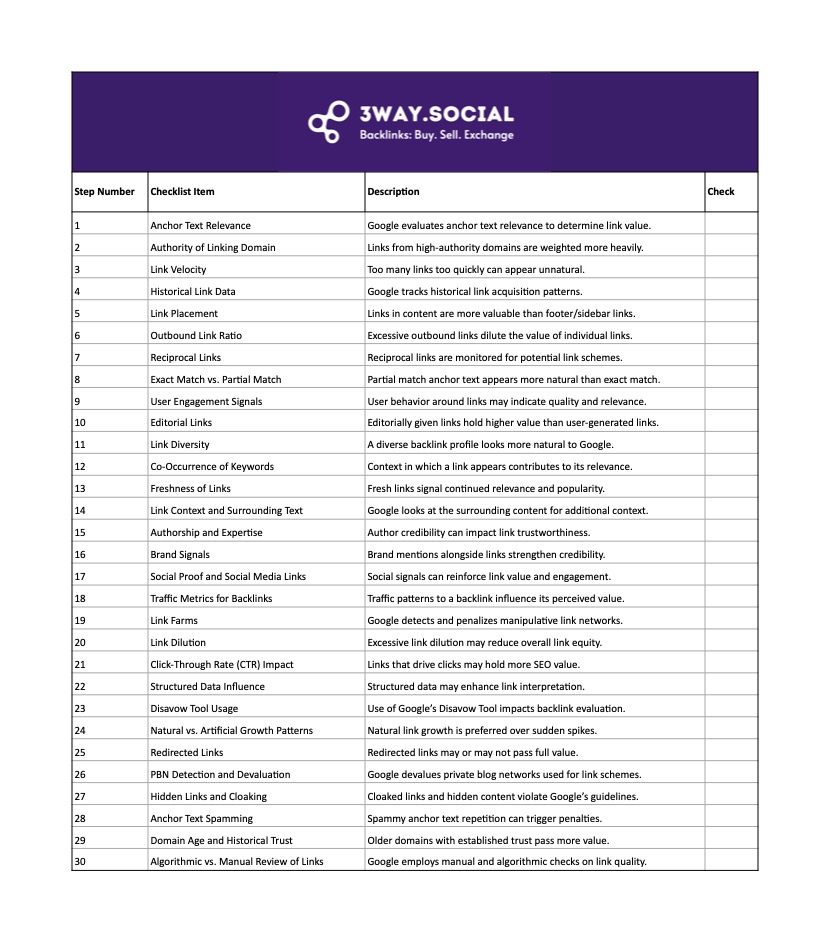Last Updated on February 26, 2025 by Becky Halls
Introduction
Backlinks have been a game-changer in SEO since Google first started ranking websites, but let’s be real, figuring out which links help and which ones hurt can feel like decoding a secret message from space. Google has spent years fine-tuning how it evaluates backlinks, and while they love to keep us guessing, they’ve also dropped some serious hints through their Google Backlink Patents.
That’s where we come in… We’ve taken the geeky, technical, legal mumbo-jumbo of Google backlink patents and turned it into a simple, straightforward, and actually useful guide. No fluff, no vague theories – just actionable insights that help you build a killer backlink strategy without getting on Google’s bad side.
So, if you’re ready to level up your link-building game keep reading for our 30 Actionable Steps on cracking the code on Googles backlink patents…
AND… If you want a quick checklist to help you on your way then download our free PDF Checklist: Google-Backlink-Checklist-2025
Our 30 Actionable Insights on Google Backlink Patents
1. PageRank: The OG of Link Authority
- Deep Dive: PageRank is still a fundamental metric in Google’s ranking algorithm, even if it’s no longer publicly visible. It assesses the value of a page based on the number and quality of incoming links.
- Advanced Strategy:
- Acquire links from pages with fewer outbound links to maximize link equity.
- Internal linking strategically distributes PageRank across your site—avoid orphan pages!
- Test with tools like Ahrefs’ URL Rating (UR) or Moz’s Page Authority (PA) to approximate PageRank.

2. Anchor Text Relevance: Beyond Exact Matches
- Deep Dive: Google’s 2012 Penguin update started penalizing exact-match anchor text abuse. Since then, it has focused on the semantic relevance of surrounding text.
- Advanced Strategy:
- Vary your anchor text: Mix brand, partial match, and generic anchors.
- Contextual optimization: Ensure your link appears naturally within well-structured content.
- LSI keywords & co-occurrence: Google understands relationships between words—diversify your link context.
3. Link Velocity: Slow and Steady Wins the Race
- Deep Dive: Google monitors the rate at which your website acquires backlinks to detect unnatural growth spikes.
- Advanced Strategy:
- Monitor competitors’ link velocity using Ahrefs’ New/Lost backlinks feature.
- Build links consistently over time rather than in bursts.
- Seasonal fluctuations? Align link-building with product launches or industry events.

4. Domain Authority vs. Page Authority: Know the Difference
- Deep Dive: High DA doesn’t always mean a page passes strong ranking power—Page Authority (PA) can be a better indicator.
- Advanced Strategy:
- Prioritize high-PA pages over DA alone for backlink acquisition.
- Use Link Intersect tools (Ahrefs, Moz) to see which sites link to your competitors but not to you.
5. Freshness of Backlinks: New vs. Aging Links
- Deep Dive: A fresh backlink from an authoritative site signals ongoing relevance to Google.
- Advanced Strategy:
- Secure recurring mentions from industry blogs.
- Reclaim old links using link reclamation strategies (e.g., fixing 404 pages with backlinks).
6. Nofollow vs. Dofollow: Balancing Link Equity
- Deep Dive: Nofollow links may not pass direct link equity, but they still impact brand visibility and can influence rankings.
- Advanced Strategy:
- Secure nofollow links from high-traffic sources (Wikipedia, news sites).
- Aim for a natural mix of follow/nofollow for a diversified profile.
7. Internal Links: Your Secret SEO Weapon
- Deep Dive: Internal links transfer authority within your own site, helping distribute link equity effectively.
- Advanced Strategy:
- Use silo structures: Group related content with strategic internal links.
- Test anchor text variations for internal links to see which drive the most engagement.

8. Outbound Links & Authority Signals
- Deep Dive: Linking to authoritative sources can enhance content credibility and improve rankings.
- Advanced Strategy:
- Link out sparingly: Keep high-quality external links to 2-3 per article to maintain authority.
9. Link Context: The Power of Surrounding Text
- Deep Dive: The semantic relevance of the surrounding text enhances backlink power.
- Advanced Strategy:
- Ensure backlinks are placed inside high-value, contextual sentences.
10. Placement of Links: Header vs. Footer Links
- Deep Dive: Google devalues boilerplate footer/sidebar links but rewards in-content links.
- Advanced Strategy:
- Aim for above-the-fold, body-content placements for stronger impact.
11. Reciprocal Linking: When It’s Too Much
- Deep Dive: A few natural reciprocal links are fine, but excessive link swapping can trigger penalties.
- Advanced Strategy:
- Use triangular link-building strategies instead (Site A → Site B, Site B → Site C, Site C → Site A).
12. Social Signals: The Underrated Link Factor
- Deep Dive: Google doesn’t directly count social links but uses social engagement signals to validate content popularity.
- Advanced Strategy:
- Amplify backlinks on social media for secondary ranking signals.

13. Unlinked Brand Mentions: Reclaim Lost Opportunities
- Deep Dive: Google understands brand mentions, even without links.
- Advanced Strategy:
- Use Google Alerts or Ahrefs’ Content Explorer to find and convert unlinked mentions.
14. Content-Based Link Building: Creating Evergreen Link Magnets
- Deep Dive: Long-form, research-backed content consistently earns natural backlinks.
- Advanced Strategy:
- Publish original research, statistics, or case studies.
15. The Role of Citations in Local SEO
- Deep Dive: Citations (even without links) boost local search visibility.
- Advanced Strategy:
- NAP (Name, Address, Phone) consistency across all citations is critical.

16. The Power of Broken Link Building
- Deep Dive: Finding and replacing broken outbound links on authoritative sites is one of the easiest white-hat link-building techniques.
- Advanced Strategy:
- Use Check My Links (Chrome extension) to find broken links quickly.
17. Press Releases & News-Based Backlinks
- Deep Dive: Google devalues spammy PR backlinks, but newsworthy press mentions still hold weight.
- Advanced Strategy:
- Use HARO (Help a Reporter Out) to land genuine press backlinks.
18. Guest Posting: Still Effective, If Done Right
- Deep Dive: Guest blogging should focus on relevance and quality.
- Advanced Strategy:
- Avoid guest post farms—Google now devalues sites that only publish guest posts
![]()
19. Link Farms: How Google Detects & Penalizes Them
- Deep Dive: Link farms are networks of websites created solely to generate backlinks in an attempt to manipulate rankings. Google’s Penguin update cracked down on these practices.
- Advanced Strategy:
- Audit backlinks regularly using Ahrefs or Google Search Console to ensure you’re not associated with spammy sites.
- Disavow toxic links via Google’s Disavow Tool if you suspect link farm involvement.
- Prioritize organic link-building strategies such as digital PR, guest posts, and high-quality content creation.
20. Link Dilution: How Too Many Links Decrease Value
- Deep Dive: Link equity (PageRank) is divided among all links on a page. If a page has too many outbound links, each link passes less SEO value.
- Advanced Strategy:
- Limit outbound links per page to maintain authority.
- Ensure that internal links distribute link equity strategically across important pages.
- Use nofollow attributes for unimportant links (e.g., social media, external citations that don’t benefit SEO).
21. CTR (Click-Through Rate) & Link Value
- Deep Dive: Google’s RankBrain algorithm prioritizes user engagement metrics, including CTR on search results and backlinks.
- Advanced Strategy:
- Optimize anchor text to make backlinks more clickable (e.g., use compelling CTAs like “See how this strategy increased traffic by 300%” instead of generic “click here”).
- Get links from high-traffic pages—use Ahrefs’ Top Pages report to identify content that attracts clicks.
- Encourage engagement on linked pages by improving readability, design, and UX.

22. Structured Data & Backlinks: A Hidden SEO Boost
- Deep Dive: Google rewards structured data (Schema Markup) because it helps search engines understand content better. This, in turn, can improve rich results and increase the effectiveness of backlinks.
- Advanced Strategy:
- Use Schema.org markup to enhance page content for better SERP performance.
- Implement FAQ, How-To, and Breadcrumb Schema on pages receiving strong backlinks for better CTR.
- Test structured data with Google’s Rich Results Testing Tool to ensure correct implementation.
23. The Role of Traffic in Link Valuation
- Deep Dive: A backlink from a high-traffic page is more valuable than one from a dead or low-traffic page.
- Advanced Strategy:
- Use SimilarWeb or Ahrefs’ Top Pages to target high-traffic pages for link outreach.
- Focus on earning backlinks from pages that already rank well, increasing visibility.
- Test referral traffic from backlinks using Google Analytics UTM tracking.
24. Redirected Links: Do They Pass Link Equity?
- Deep Dive: Google passes some link equity through 301 redirects, but not 100% of it. Multiple redirects in a chain reduce link juice transfer.
- Advanced Strategy:
- Avoid unnecessary redirect chains—use direct 301 redirects instead.
- Audit and fix broken backlinks that may have been redirected multiple times.
- Test redirect impact using Ahrefs’ Site Explorer to check if links are still passing authority.

25. Exact-Match vs. Partial-Match Anchor Text
- Deep Dive: Over-optimized exact-match anchor text triggers penalties, while partial-match and branded anchors are safer.
- Advanced Strategy:
- Use 70% branded/navigational anchors, 20% partial-match, and only 10% exact-match to avoid spam signals.
- Analyze competitors’ anchor text ratios using Ahrefs’ Backlink Profile tool.
- Ensure that anchor text fits contextually—Google now evaluates surrounding content.
26. Trust & Authority: What Signals Matter?
- Deep Dive: Google considers E-E-A-T (Experience, Expertise, Authoritativeness, and Trustworthiness) when evaluating backlinks.
- Advanced Strategy:
- Prioritize backlinks from high-authority domains (e.g., .gov, .edu, and trusted industry sites).
- Get mentioned by experts—Google associates authoritative authors with trustworthy links.
- Improve on-site trust factors by using HTTPS, displaying author bios, and citing sources.
27. Negative SEO & Toxic Backlinks
- Deep Dive: Competitors or black-hat SEOs may send spammy backlinks to harm rankings.
- Advanced Strategy:
- Regularly audit backlinks with Ahrefs or SEMrush.
- If attacked with toxic links, submit a Google Disavow file.
- Use brand monitoring tools (e.g., BrandMentions, Google Alerts) to detect link spam campaigns early.
28. Image Backlinks: The Overlooked Link-Building Strategy
- Deep Dive: Google indexes and ranks images separately, allowing backlinks from image sources to pass value.
- Advanced Strategy:
- Use reverse image search (Google Lens, TinEye) to find and reclaim uncredited image links.
- Infographic outreach: Create and distribute branded infographics with embedded backlinks.
- Optimize alt text and captions to ensure images rank in Google Images.

29. Video Backlinks: YouTube & Beyond
- Deep Dive: Google prioritizes YouTube and video content—embedding videos in content increases backlink potential.
- Advanced Strategy:
- YouTube descriptions: Add contextual backlinks to video descriptions.
- Guest vlogging: Collaborate with influencers to embed backlinks in their video content.
- Transcribe video content into written blogs to generate additional link opportunities.
30. The Future of Backlinks: AI & Machine Learning
- Deep Dive: AI and machine learning are reshaping link building, as Google moves toward entity-based indexing instead of just PageRank-based authority.
- Advanced Strategy:
- Leverage AI-generated content carefully—Google values human-reviewed, high-quality information.
- Use AI to optimize outreach: Tools like BuzzStream and Pitchbox help identify high-value link opportunities.
- Track Google’s evolving patents on backlinks and algorithm changes to stay ahead.

Final Thoughts: Google Backlink Patents in 2025 & Beyond
Backlinks remain one of Google’s top ranking factors, and the Google Backlink Patents remain a key way to understand how they work, but context, trust, and relevance matter more than ever. With AI-driven search algorithms and semantic indexing, the future of link building will reward high-quality, user-first strategies over manipulative tactics.
What’s Next?
- Download the 30 Actionable Steps Google-Backlink-Checklist-2025 — a handy PDF to keep check of your progress wherever you are!
- Audit your backlinks today – remove toxic links and reinforce high-value ones.
- Keep up to date – the Google Backlink Patents are always being updated so make sure you’re up to date with any recent changes.
- Explore AI-powered SEO tools – test on-page elements using PageTest.AI.




